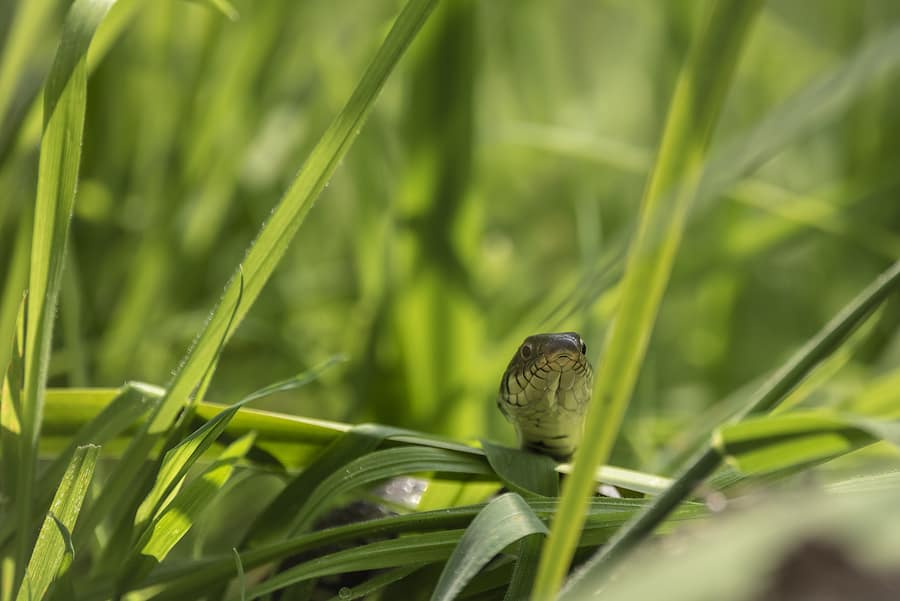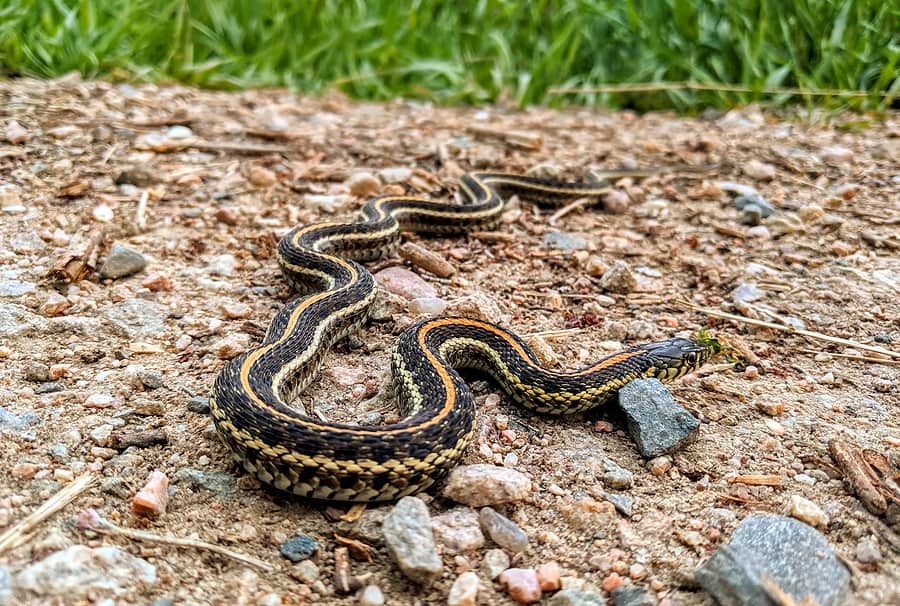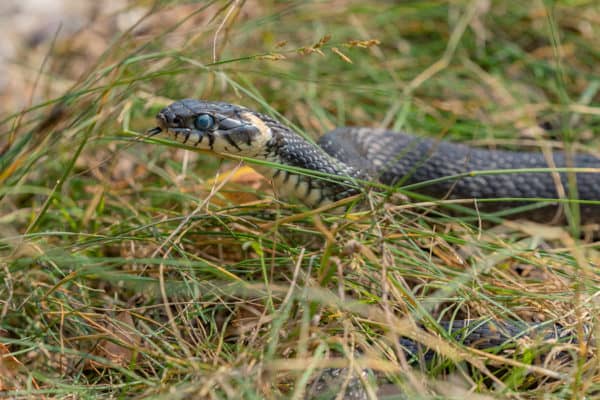READY TO GET STARTED?
REQUEST A FREE ESTIMATE
Fill out the form below or call (888) 466-7849 for a free, no-obligation estimate.

While most snakes you encounter are harmless, many of us still don’t want to come across one in our yard or home. While our first instinct may be to run, most snakes are actually beneficial to have around – they help keep other pest populations under control (rodents, frogs, etc.).
Snakes will come into your yard in search of 2 things: shelter and food. Snakes will seek out shelter to have a place to rest, breed, and hunt. Common places snakes are found include overgrown grass, dense brush or shrubs, leaf piles, rock piles, compost, or areas with moisture like underneath bird baths, around leaky faucets and hoses, or near ponds or swimming pools. Snakes will also come looking for food. Snakes love to eat rodents, moles, frogs, fish, snails/slugs, and other small insects.
If you prefer not to encounter snakes around your home, here are 7 natural ways you can keep snakes away.
Snakes will come around looking for food so if your home provides them with that, you’ll be more likely to encounter them. Getting rid of these food sources will encourage snakes to move along in search of something to eat. Make sure common pests that snakes like to eat are kept under control. Scheduling routine pest control can help with this.
Snakes are also attracted to areas with a lot of moisture. Eliminate standing water in your yard where possible. Repair leaky faucets and replace leaky hoses. Keep pools, ponds, and other water features maintained. If using sprinklers, make sure they are running in the morning so the water has time to soak in or evaporate before it gets dark. This helps keep soil in your yard from being too wet.
Snakes will look for places around your home to hide so they can breed and rest. Get rid of coiled hoses or use hose boxes. Avoid using rock piles in your landscaping, if possible. Store firewood in boxes or elevate it when possible. Keep your grass mowed and dense brush cleared out. Seal off or add fencing to any open areas under sheds or other buildings. If you are using snake-proof fencing, make sure it is made of steel mesh or plastic sheeting, it is at least 3 feet high and 4 feet deep, it is flush with the ground, and it is angled outward.
Some plants are known to repel snakes. Try to incorporate these plants into your landscape design where possible. Common snake-repelling plants include marigolds, lemongrass, Mother-in-Law’s tongue, wormwood, onion, and garlic.
Gophers, moles, and voles dig burrows across your yard. Once they’ve been eliminated, these old gopher holes and burrows can remain on your property. Snakes will commonly use them for shelter as they provide a great place for them to hide, rest, and breed. Fill in any of these holes and burrows with dirt or gravel. This will help deter snakes from using them.
Snakes have a few natural predators that can help keep them away. Common snake predators include cats, raccoons, pigs, turkeys, guinea hens, and foxes. Keeping any of these animals around your home will help deter snakes from coming near. You can also buy fox urine and sprinkle it around your property to help deter snakes, as well.
There are several natural products that are known to repel snakes. These natural snake repellents can be used around the perimeter of your property, around pools, along the edges of ponds, and anywhere else you have noticed snake activity.
Despite our best efforts, snakes can still make their way into our yards and homes. If you have a problem with snakes, contact your local pest control company who specializes in snake removal who can help you properly identify the type of snake you have (venomous vs nonvenomous) and help safely and humanely remove it from your property.
How Do Cockroaches Get Into the House?
Identify and Prevent Brown Recluse in Your Tennessee Home

Snakes are one of the most feared pests homeowners can find in their yards. The likelihood of snakes coming onto your property depends on several factors like your location, surrounding landscape, nearby water source, available food supply, and your landscaping and maintenance. While the first instinct is usually to either run or get rid of it quickly, snakes can actually be pretty beneficial to have around. Instead of killing snakes, some people prefer to try and repel them to keep them from coming into the yard in the first place, or deter them from staying there if they’ve already taken up residence. There are several snake repellent products on the market, but do any of them really work? Here are some of the most common snake repellents, the reasons why you should avoid them, and some snake prevention tips you can use around your home.
Mothballs are one of the most popular snake repellent products. The active ingredient in mothballs is either naphthalene or paradichlorobenzene. Both of these products are known to be toxic to insects and mammals but are actually not effective on snakes (because they are actually reptiles). In fact, naphthalene has been proven to cause illness in humans (especially children) and pets. Additionally, using mothballs outside the home actually violates their product labels.
Sulfur is another common snake repellent ingredient and is often seen in many commercial snake repellent products on the market. Sulfur has been proven to not be effective against snakes, however, much the same as mothballs.
When snakes are terrorizing a chicken coop, many people will use ceramic or wooden eggs or even golf balls to trick snakes into eating them instead of real chicken eggs. The problem, however, is that when snakes eat these fake eggs they die a long, slow, painful death over the course of many weeks. Once they’re gone, another snake will often show up and take its place, defeating the purpose of eliminating the original snake. If you are using ceramic eggs to encourage your hens to lay, make sure to glue them down so snakes can’t eat them accidentally.
Many people will catch and release predatory snakes like king snakes and racers onto their property to hunt and kill the problematic snakes they have. This practice is usually unsuccessful and in some places is even against the law. The same goes for capturing the problematic snakes on your property and releasing them elsewhere.
Some people will lay out sticky traps in hopes of catching the nuisance snake so they can kill it or relocate it. The problem with this method is that the sticky traps will often catch non-targeted animals instead of the snake, resulting in a slow, agonizing death for the animal.
Many people employ guns or shovels to kill snakes that come onto their property. This puts people at great risk for injury either from the snake going on the defensive and biting its attacker or from the homeowner or innocent bystanders being injured by ricocheting bullets, etc. Once the snake is killed, it is often replaced by another snake that takes its place. A better deterrent for snakes is to spray them with a blast from the water hose. This encourages them to find a new location without harming them or anyone else.
Instead of using ineffective snake repellent products and methods, consider going to the source of the problem to help get rid of it. Snakes will come into your yard because they are attracted to something there – whether it is a water source, food source, or a place to shelter. Eliminating what attracts them will help keep them out and encourage them to find a different location to live in. Here are some snake prevention tips you can utilize to help make your yard less inviting to them.
The large majority of snakes you will encounter in your yard are harmless to humans. All snakes (even venomous snakes) are beneficial and play an important role in the ecosystem. Many snakes eat garden pests like slugs and snails, helping protect your plants and flowers. Some snakes eat rodents, helping control their populations and keeping them from spreading diseases to you, your family, your pets, and your livestock. There are even studies showing where rattlesnakes help keep Lyme disease in check. If you’ve tried the tips above and you still have an issue with snakes or any other pests, contact your local pest control company for a comprehensive evaluation and treatment plan.
The Traveler’s Guide to Bed Bugs
Take the Homework, Leave the Lice

If you live in an area where snakes are common, chances are you may stumble across one at some point. Snakes, like any other pest, are usually in search of three things: food, water, and shelter. Oftentimes the area around our homes provides all of these things that attract snakes.
The likelihood of a snake on your property depends on several factors, including location (north vs south), landscape (urban vs rural), a nearby water source (pond, lake, river), how well your lawn is landscaped and maintained, and how readily a food supply is available.
When dealing with snakes, it is important to identify the type of snake you are dealing with: venomous snakes should be left to a professional to eliminate while non-venomous snakes can often be deterred with natural snake repellent techniques. Here are 4 ways to keep snakes out of your yard:
One of the easiest ways to scare off a snake from your yard is to use your garden hose. Spray the snake with a steady stream from the hose until he slithers off. Consider installing a perch pole for hawks, owls, and other natural snake predators to alight on. Be sure to place it in an open area so the birds have a good view of your yard and the surrounding area.
There are some natural products and at-home techniques you can use for snake prevention. Ammonia is a common snake repellent. Snakes hate the smell of ammonia and won’t come near it. Soak rags in ammonia and place them in unsealed plastic bags. Leave the bags where you usually see snakes to keep them away.
You can also use vinegar to keep snakes and other pests out of your swimming pool. Pour white vinegar around the perimeter of the pool. Snakes can absorb the vinegar through their skin, so they will avoid slithering over it once it’s poured on the ground. Snakes also try to avoid humans at all costs. Save hair from your hairbrush and scatter it around the perimeter of your property to help keep snakes away.
Snakes will come into your yard in search of food, water, and shelter. Eliminating these three basic necessities will make them much less likely to pay you a visit. Mow your grass often and keep it cut short. Shorter grass means more exposure to predators like hawks and coyotes and also makes them much easier for you to spot.
Avoid overwatering your lawn, as this can attract snake food sources like frogs, worms, and slugs. Keep trees, shrubs, and branches trimmed away from the sides of your house, the roof, and the ground. Try to keep a 24 to 36-inch space cleared under trees and shrubs, as this reduces the chance of snakes using them for cover and makes them easier to spot. Move bird feeders away from the house or get rid of them altogether.
Birds often leave seeds scattered underneath which attracts rodents that, in turn, attract snakes. Keep bird seed and pet food stored in metal cans with tight-fitting lids.
Make sure your woodpile is kept away from the home and elevated if possible. When designing your landscaping, try not to use mulch or large rocks, as these create breeding grounds and overwintering habitats for snakes. Instead, try to use smaller, tight-fitting rocks like gravel or river rock. Also, try to avoid using water features and Koi ponds as the water can also attract snakes.
Snakes can be very persistent pests, and keeping them out can be difficult. Carefully inspect the outside of your home and seal any cracks or crevices you find on the house, sidewalk, and foundations. Consider installing fencing around your yard, garden, or pool.
Fencing should be buried a few inches into the ground and constructed using 1/4″ rigid mesh or solid sheeting. Fencing should also include a bend at the top to prevent snakes from climbing up and over. There are some companies that even make wildlife-specific fencing.
The best way to prevent snakes is to take steps to keep them out in the first place. Dealing with snakes can be dangerous, depending on the type of snake you have. If you have a snake problem, contact animal control or a professional wildlife control company that can help safely trap, relocate, or remove the nuisance snake from your home.
What You Should Know About Termites This Spring
Where Are These Stinkbugs Coming From?